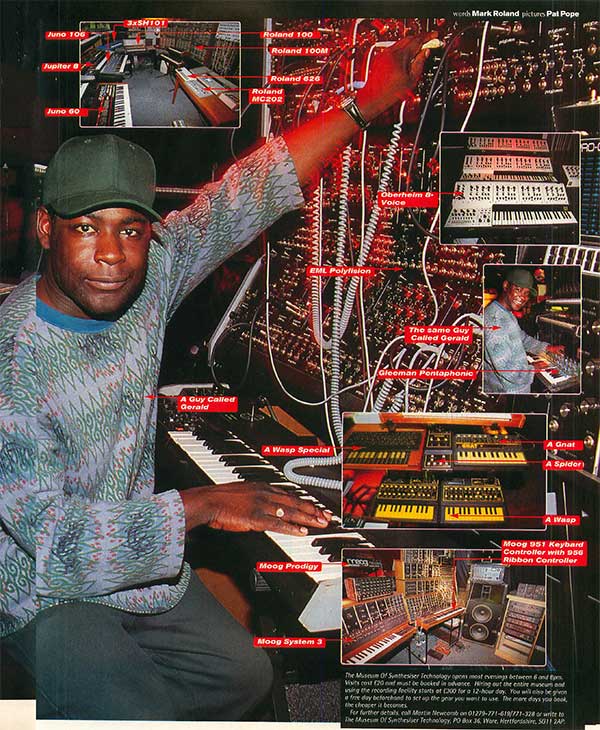| Midi Madness | |
 |
Muzik No 2 July 1995 Page: 96 |
 A GUY CALLED GERALD goes ga-ga in the analogue haven of the MUSEUM OF SYNTHESISER TECHNOLOGY YOU MAKE MUSIC WITH YOUR OWN MIDI set-up. You want to sound cool and groovy. You have been trying to track down a Roland TB303. You find one, pay upwards of £500, and then have to fork out around another £200 for a midi retrofit. You are quite clearly mad. You are not, however, half as mad as Martin Newcomb. In a massive bunker tucked away in deepest Hertfordshire, Martin has amassed the most staggering collection of vintage synthesisers known to man. Walking down the stairs into the Museum Of Synthesiser Technology, it's difficult not to gasp in awe at the sight of several hundred keyboards set out in an easily negotiated maze, all wired up and ready to play. Well-known workhorses sit beside obscure one-offs made in Russia and virtually every Moog made is represented. So are numerous gigantic modular systems, most of which weigh several tonnes. Gerald Simpson, aka ambient jungle man A Guy Called Gerald, who has come to test out some of the museum's gear, is delirious. "Oh man," he whispers. "I think I've died and gone to synthesiser heaven." IT all began as a hobby just four years ago. Newcomb had made a stack of cash as a foreign exchange dealer in the City, a job he retains to this day, and was looking for something interesting to spend it on. "I'd been into electronic music since the late Sixties," he recalls. "I was a big fan of people like Klaus Schultze, Tangerine Dream and later Emerson, Lake And Palmer. I'd always dreamed of owning one of Keith Emerson's 3Cs, which is basically how the ball started rolling." The first pieces in Newcomb's collection were a decidedly un-vintage JD800 and a Proteus II with an Atari. To these he added an ARP 2600, a small EMU Modular, a Mini Moog and a Memory Moog, by which point he had embarked on a period of frenzied collecting. Many of the synths came via a contact in America, who cruised the country armed with the knowledge that there was an English headcase willing to pay top dollar for items which were rare enough and in good enough nick. As the collection grew, people started turning up to look at it, and chez Newcomb mutated into a fully-fledged museum. It was officially opened a little under a year ago by none other than Dr Robert Moog, with Youth and Underworld's Rick Smith among the dozens of famous names on the guest list. THE synth wonderland is divided into several sections. There's the Moog corner, the ARP nook, the Roland cranny and, along the way, multifarious odds and sods. Each has its own mixer and PA and, in turn, each mixer runs into a central space in which an enormous Soundcraft desk handles all the signals and routes them onto ADAT. An Apple Centris also lurks here. With what must be a terrifying array of midi/cv converters and cables, this is able to sequence the entire place into a cacophony of analogue sounds. Although Martin Newcomb's love for this now ageing technology is rooted in his adoration of the prog rock dinosaurs of the Seventies, it is the dance boffins of the Nineties who are flocking to the museum. And Newcomb hits the nail squarely on the head when he talks about their fascination for analogue gear. "People are losing faith in the synthesisers of today. Musicians are not computer scientists and they're fed up with spending most of their time in front of a screen. They want to get back to fiddling with instruments. They want to develop sounds from scratch rather than just be given a pre-set." SQUANK! Squidge!! Wibble!!! Gerald has turned on the perspex Gleeman Pentatonic at the far end of the room, one of only 50, which were made in 1983 by the Californian Gleeman Brothers. It cost just over £1,500 when it first came out and would probably set you back about the same price now. Assuming you actually managed to find one, that is. With five voices and three oscillators per voice, it can really belt out some stomach-churning bass noises and truly wild, erm, squanks and squidges. "I think I've found the one they used for 'Star Trek'," laughs Gerald. Next on Gerald's tour is an Oberheim 8-Voice. The four-octave keyboard is tiny, but the control panel stretches way off into the distance and is festooned with more knobs than a "Colour Climax" video. Originally manufactured in 1976 and selling for a whopping (7,500, it boasts almost endless permutations. After a none too subtle twiddle of the frequency and resonance in the VCF, it offers up the meanest, fattest bassline you're ever likely to hear. With the addition of SEMs (Synthesiser Expander Modules) this glorious machine could apparently have up to 12 voices, but this is merely a rumour talked about in hushed tones among enthusiasts. LET'S cut to the chase. How much has this lot cost? "I'm not saying," laughs Martin Newcomb. Go on, we won't tell anyone. "Some estimates have put it at about £100,000 and others at closer £1 million," he answers, coyly. Looking around, the latter would seem to be closer to the mark. Like everybody else, Newcomb is unimpressed with the cost of vintage gear in recent years. "I really can't believe what people have to pay for, say, a TR909. It's becoming a joke. A few years ago, you could pick them up for £200, and then sell them on for £400. Now they've doubled in price again. It's crazy. Three years ago, I bought an EMS VCS 3 for £500. Now you see them for £1,500." Part of the reason is that so much of this equipment has not stood the test of time, ending up in skips as the musos of the early Eighties embraced the digital glory of Yamaha's DX7. To prove the point, at a recent music fair where Newcomb had a stand, a man recognised the modular system on show as being similar to one, which a friend of his had bought in a jumble sale 10 years earlier. It was still boxed up in his garage. Newcomb had to tell him it was worth £3,000. There is also the story of the chap who, in 1983, swapped his DX7 for his friend's Moog Modular System. As part of the agreement, the two men had a one-month trial period, at the end of which the first decided he couldn't come to terms with the Moog Modular and wanted his DX7 back. The swap was off. And now? A DX7 is yours for £200, while a Moog Modular will cost you over £9,000. A word of warning, though; Newcomb says that the spiralling costs of 303s, 909s and 808s will sooner or later come spiralling back down. "Those machines are in demand because they feature today's club music sounds, but that popularity probably won't last forever," he says. "They could well be back down to £100 in a few years. By contrast, classics like the Mini Moog and the ARP 2600 will always be highly sought-after." GERALD is shaking his head in a mixture of disbelief, admiration and jealousy, with a little nostalgia thrown in for good measure. Visiting the Museum Of Synthesiser Technology has revived memories of the time when he'd spend hours fiddling with a Korg MS-20 in Manchester's Al music shop. "I used to get lost in the sounds, and you would never get the same noise twice," recalls Gerald wistfully. "These days, I usually delve deep into the Akai S950 for my sounds, but now and again I'll go back to the old synths and layer them on the Akais." When he does work with synthesisers, Gerald has the choice of a JD800, a Jupiter 8, a Juno 106, an SH 101, a couple of 303s, one of which was the first instrument he ever bought, and a TR606 Drumatix. As a man who spent years triggering two 101s and a 303 off an 808 because he couldn't afford any new midi gear, a technique which can be heard to blinding effect on his "Voodoo Ray" single, Gerald Simpson knows his analogue onions. But he has to tip his baseball cap to Newcomb's museum, and he'll certainly be back for more. "I recently brought a friend of mine down from Manchester to work in my studio in London," says Gerald. "I'm teaching him programming and recording, and it'll be really useful to get him down here. All the modern equipment, even the Akai 53200, has the same basic principles as the old synths. It's brilliant to see how and where it all started." A Guy Called Gerald's 'Finley's Rainbow' single is out on Juice Box on June 26. [Author: Mark Roland, Photos: Pat Pope] |
|